Thiruvairanikulam Mahadeva Temple
The Thiruvairanikulam Mahadeva Temple, nestled near Kalady in Kerala’s Ernakulam district, boasts a rich and intriguing history shrouded in legend and faith. While its exact origins remain shrouded in the mists of time, estimates place its construction sometime between 1000 and 2000 years ago, making it one of the ancient temples dedicated to Lord Shiva and Goddess Parvathy in Kerala.
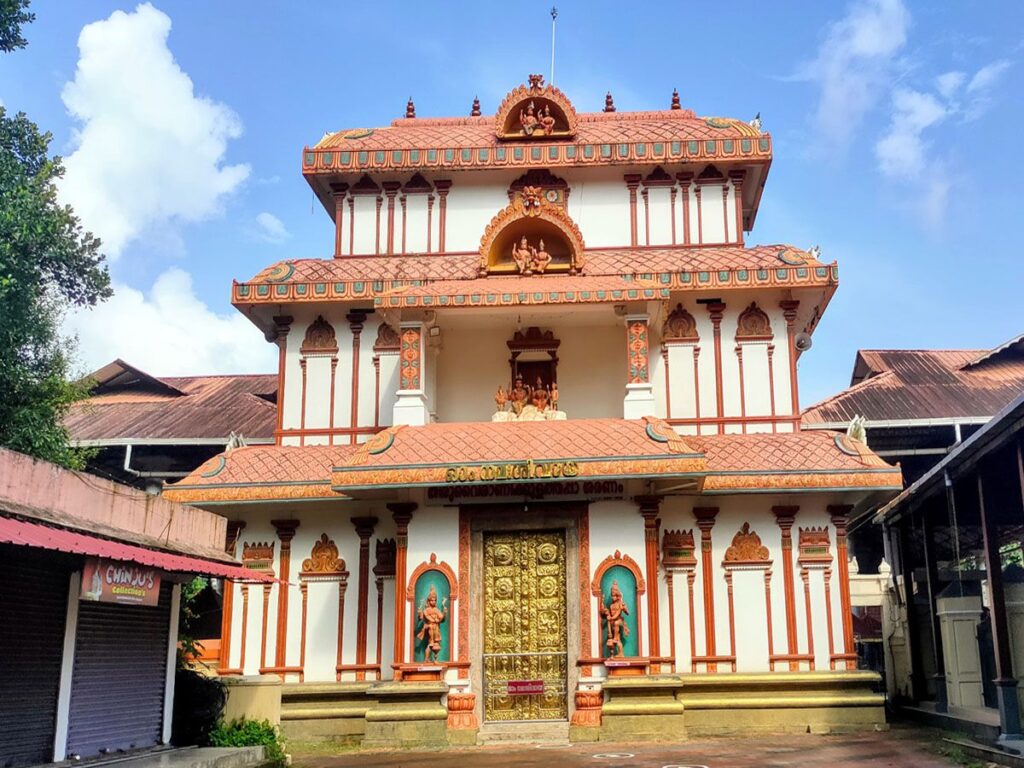
Contents
- 1 History of Thiruvairanikulam Mahadeva Temple:
- 2 Myths of Thiruvairanikulam Mahadeva Temple:
- 3 Thiruvairanikulam Mahadeva Temple Architecture:
- 4 Significance of Thiruvairanikulam Mahadeva Temple:
- 5 Thiruvairanikulam Mahadeva Temple Timing and Rituals:
- 6 Specialty of Thiruvairanikulam Mahadeva Temple:
- 7 Places to visit near Thiruvairanikulam Mahadeva Temple:
- 8 FAQ:
- 9 How to reach Thiruvairanikulam Mahadeva Temple:
- 10 Google Maps:
History of Thiruvairanikulam Mahadeva Temple:
Origins shrouded in legend:
- Two prominent narratives trace the Thiruvairanikulam temple’s origin. One speaks of a conflict within the Akavoor Mana family, leading a section to Vellarapilly. They discovered a self-manifested stone idol of Lord Shiva, named Airanikulathappan. Recognizing it as divine, they built a temple around it, and the name evolved to Thiruvairanikulathappan.
- Another legend tells of two Brahmin families, Akavoor Manakkal and Akavoor Chathan, finding solace in worshipping different forms of the same deity. While Manakkal worshipped Lord Shiva, Chathan revered Goddess Parvathy. Both forms eventually found their place in the temple, symbolizing unity in duality.
Ancient roots:
- Though the exact timeline remains debated, historical references and architectural style suggest the temple dates back centuries. Some estimates place its origins in the early medieval period, while others believe it could be even older.
Unique features and traditions:
- Thiruvairanikulam temple’s distinct layout sets it apart. Lord Shiva and Goddess Parvathy’s sanctums face opposite directions, a deviation from the usual practice. Parvathy’s sanctum opens only for 12 days during the Dhanu month, attracting a surge of devotees, especially women, earning it the nickname “Women’s Sabarimala.”
- Other notable features include intricate wood carvings, murals depicting celestial battles and deities, and shrines dedicated to various celestial beings like Nandi, Vishnu, and Dharmasastha.
Read More>> Treta Yuga Vaikom Mahadeva Temple
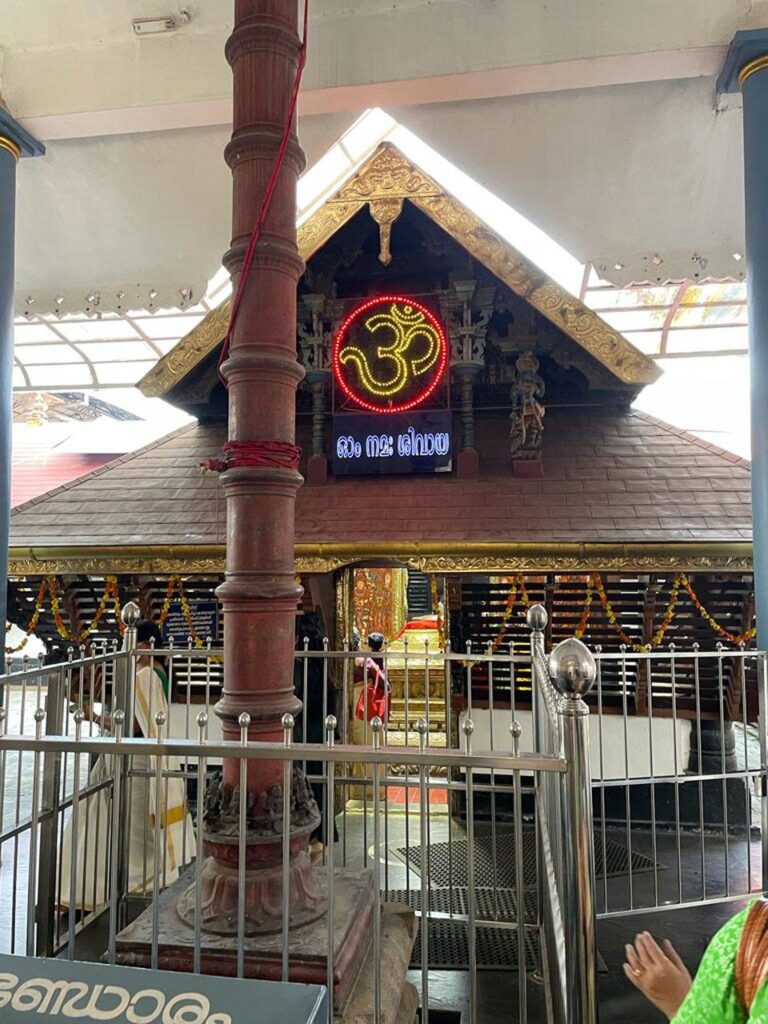
Myths of Thiruvairanikulam Mahadeva Temple:
The legend of Agni: According to one legend, the fire god Agni was cursed by the sage Bhrigu and lost his radiance. To regain his lost glory, Agni worshipped Lord Shiva at Thiruvairanikulam, and with Shiva’s blessings, his radiance was restored.
The legend of Parvati: Another legend says that Parvati, the consort of Lord Shiva, once took the form of a cow and wandered the earth. She reached Thiruvairanikulam and rested under a Vilva tree. Pleased with the devotion of the people of the village, Parvati revealed her true form and blessed them.
The legend of the five lingams: It is believed that there are five lingams (representations of Lord Shiva) in the Thiruvairanikulam temple, each representing a different aspect of the god. The first lingam is said to represent creation, the second lingam protection, the third lingam destruction, the fourth lingam knowledge, and the fifth lingam liberation.
The legend of the Nandi: The temple has a large statue of Nandi, the bull who is the vehicle of Lord Shiva. According to legend, the Nandi statue was once stolen by the king of Kanchipuram, but it miraculously returned to Thiruvairanikulam.
Thiruvairanikulam Mahadeva Temple Architecture:
Sanctum Sanctorum (Sreekovil):
- Constructed with granite blocks, the sanctum sanctorum houses the Shiva lingam and the idol of Goddess Parvathy.
- The sanctum features intricate wood carvings on its walls and ceiling, depicting various scenes from Hindu mythology.
- Notably, the sanctum sanctorum of Goddess Parvathy is only open for 12 days a year, adding to the Thiruvairanikulam temple’s mystique.
Namaskara Mandapam (Pavilion):
- This pillared hall stands in front of the sanctum sanctorum and serves as a space for devotees to offer prayers.
- The ceiling of the Namaskara Mandapam is adorned with beautiful paintings showcasing episodes from the battles between gods and demons, divine festivals, and the nine planets (Navagraha).
Read More>> Sabarimala Temple: Abode of Lord Ayyappa
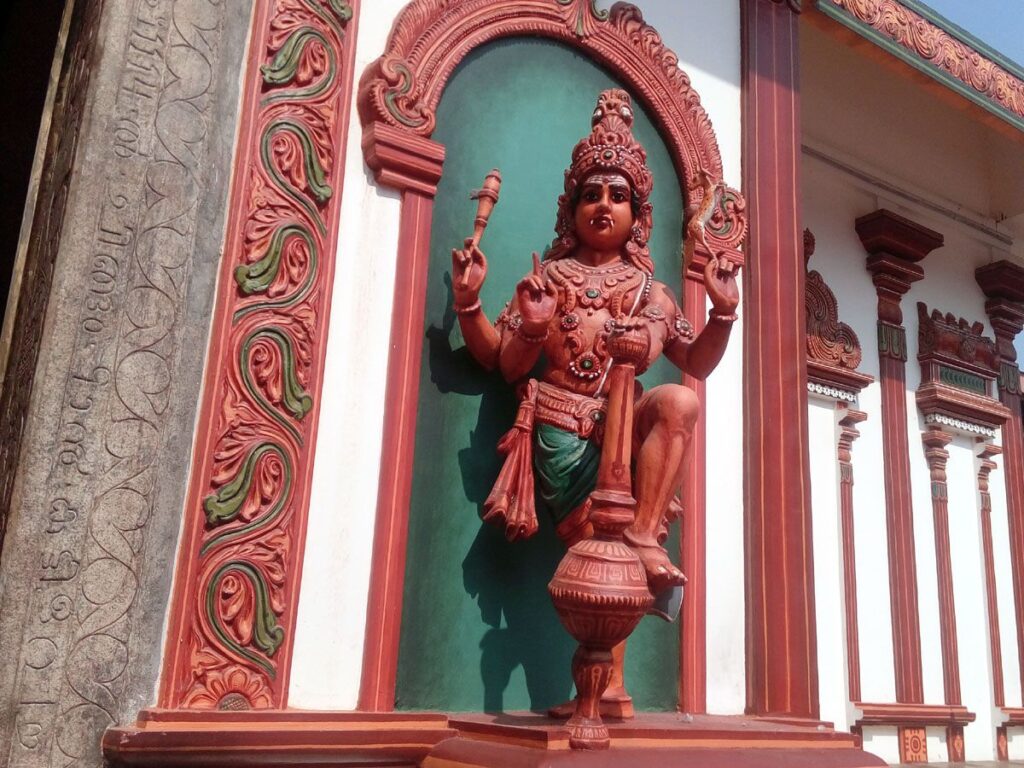
Significance of Thiruvairanikulam Mahadeva Temple:
Historical Significance:
- One of the oldest Shiva temples in South India, believed to be over 1200 years old.
- Finds mention in the Thevaram hymns by Sundarar Murthi Nayanar, one of the four Saiva Acharyas, making it a Paadal Petra Sthalam, one of the 276 temples revered in the Saiva canon.
- Associated with the Chera Empire, with the deity worshipped as their official god and mentioned in the state anthem of the erstwhile Travancore kingdom, Vanchi Bhumi.
- Considered the place where Parasurama, an avatar of Vishnu, sought atonement for killing his mother.
Religious Significance:
- Dedicated to Lord Shiva and Goddess Parvati, with unique features like Shiva facing east and Parvati facing west.
- Granting boons: Believed to bless devotees with happy marriages and fulfill their wishes.
- Unique practices: The sanctum of Goddess Parvati opens only for 12 days in December-January, making it a special pilgrimage time. This is why it’s sometimes called the “Sabarimala of women.”
Architectural Significance:
- Dravidian style architecture, with intricate carvings and sculptures depicting scenes from Hindu mythology.
- Beautiful temple pond, considered sacred and used for rituals.
- Lush green surroundings add to the serene atmosphere of the Thiruvairanikulam temple.
Cultural Significance:
- An important center for Saiva worship in Kerala, attracting devotees from all over the state.
- Celebrates various festivals throughout the year, with the Makara Vilakku procession in December-January being the most prominent.
- Plays a vital role in preserving the cultural heritage of Kerala.
Read More>> Trimbakeshwar Jyotirlinga Temple
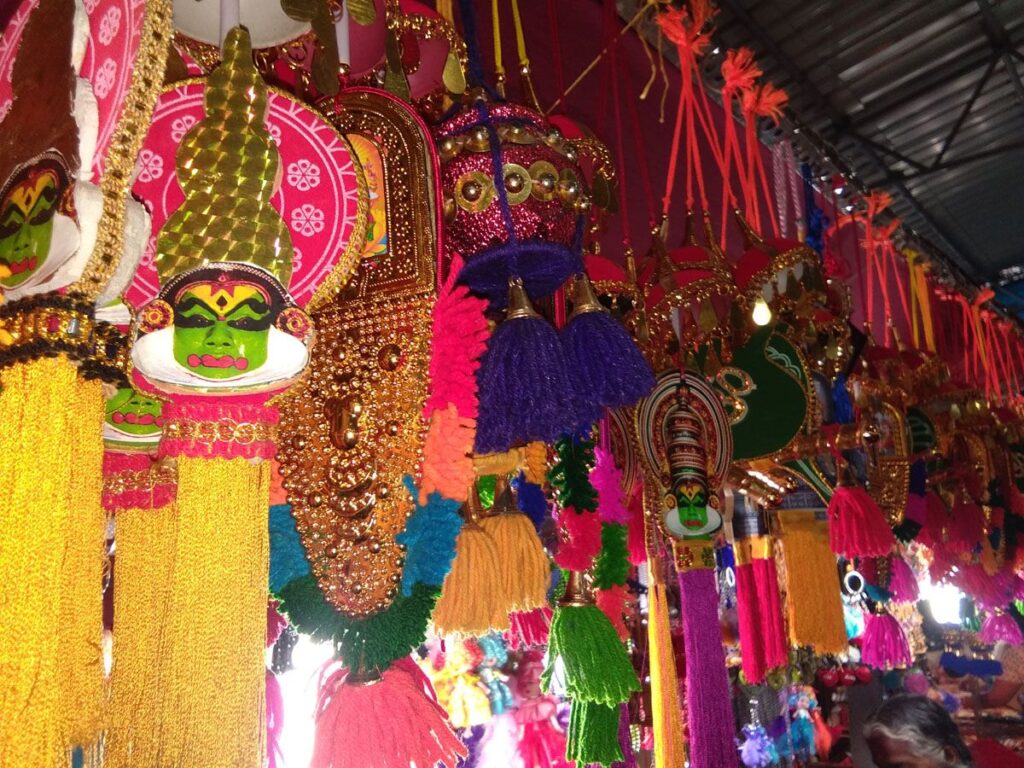
Thiruvairanikulam Mahadeva Temple Timing and Rituals:
Temple Timings:
- The temple is open from 6:00 AM to 12:00 PM and 4:00 PM to 8:00 PM.
- The pooja timings are as follows:
- Abhishekam – 6:00 AM
- Usha puja – 6:30 AM
- Seeveli – 7:30 AM
- Padi pooja – 8:00 AM
- Ilaneer abhishekam – 9:00 AM
- Neyyabhishekam – 10:00 AM
- Uchcha pooja – 11:00 AM
- Ezhunthara pooja – 5:00 PM
- Athma namaskaram – 6:00 PM
- Ilaneer abhishekam – 7:00 PM
- Neyyabhishekam – 7:30 PM
- Pallivetta – 8:00 PM
Rituals:
- Abhishekam: This is the main ritual of the temple, and it is performed on the idol of Lord Shiva with milk, water, panchamrutha, and other items.
- Usha puja: This is a morning puja that is performed on the idol of Lord Shiva.
- Seeveli: This is a procession of the idol of Lord Shiva around the temple.
- Padi pooja: This is a puja that is performed on the 108 steps of the temple.
- Ilaneer abhishekam: This is an abhishekam that is performed on the idol of Lord Shiva with coconut water.
- Neyyabhishekam: This is an abhishekam that is performed on the idol of Lord Shiva with ghee.
- Uchcha pooja: This is a midday puja that is performed on the idol of Lord Shiva.
- Ezhunthara pooja: This is an evening puja that is performed on the idol of Lord Shiva.
- Athma namaskaram: This is a puja that is performed on the idol of Lord Shiva for the peace of the departed souls.
Read More>> Karpaga Vinayagar Temple Pillayarpatti – 5th century Temple
Specialty of Thiruvairanikulam Mahadeva Temple:
Unusual Positioning of Deities: Unlike most temples where the deities face each other, Lord Shiva and Goddess Parvathy in Thiruvairanikulam face opposite directions. Lord Shiva faces east, while Goddess Parvathy faces west. This signifies their complementary nature and their different roles in the universe.
Goddess Parvathy’s Secret Darshan: The sanctum of Goddess Parvathy remains closed for most of the year, opening only for twelve days during the Nadathurappu Mahotsavam festival in mid-December to mid-January. This limited darshan is believed to be especially auspicious for unmarried women seeking good fortune in their love life.
Unique Rituals: The Thiruvairanikulam temple has several unique rituals, including the offering of turmeric powder instead of water for Jalabhishekam to Lord Shiva. There’s also a special Abhishekam ritual called ‘Kalabham’ performed on the last day of the Nadathurappu Mahotsavam, where devotees offer coconut water to the deities.
Architectural Marvels: The temple boasts intricate wood carvings, particularly the vyali (dragon) motifs on the Sreekovil (sanctum sanctorum). The ceiling of the Namaskara Mandapam (pavilion) features beautiful paintings depicting scenes from Hindu mythology, like the battles between gods and demons, and the nine planets (Nava Graha).
Temple’s Location and Surroundings: Situated on the banks of the Periyar River, the temple offers a serene and picturesque setting. The surrounding lush greenery adds to the spiritual ambiance of the place.
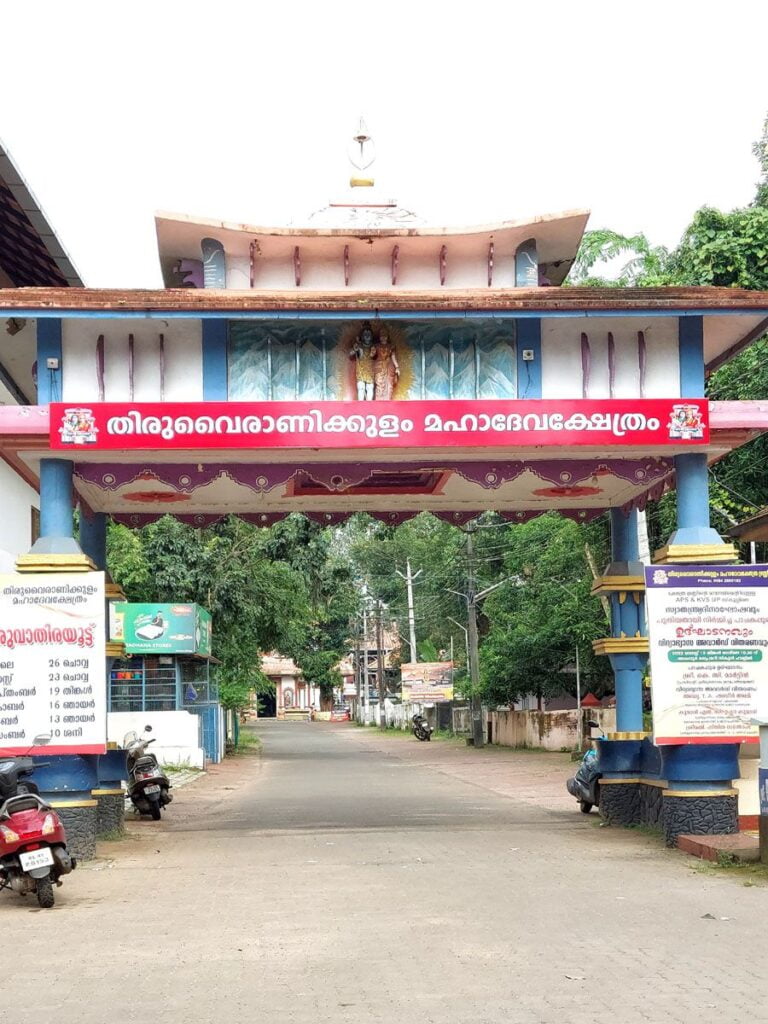
Places to visit near Thiruvairanikulam Mahadeva Temple:
- Kochi (Cochin): Explore the vibrant city of Kochi, known for its historical sites, cultural diversity, and picturesque backwaters. Visit Fort Kochi, Mattancherry Palace, Jewish Synagogue, and take a boat ride to experience the beauty of the backwaters.
- Hill Palace Museum: Located in Tripunithura, the Hill Palace Museum is the largest archaeological museum in Kerala. It showcases the erstwhile royal collections of the Maharaja of Kochi and includes artifacts, paintings, and sculptures.
- Chottanikkara Temple: This famous temple dedicated to Goddess Bhagavathy is located around 17 kilometers from Thiruvairanikulam. It is a significant pilgrimage site attracting devotees from far and wide.
- Kodanad Elephant Training Centre: Situated on the banks of the Periyar River, Kodanad is known for its elephant training center. Visitors can watch elephants being bathed and trained in a natural environment.
- Bhoothathankettu Dam: Located about 20 kilometers from Thiruvairanikulam, this dam and the surrounding area offer a scenic landscape. It’s a popular spot for picnics and nature enthusiasts.
- Malayattoor Church: If you’re interested in religious sites, Malayattoor Church, located atop the Malayattoor Hill, is a significant Christian pilgrimage center. It offers panoramic views of the surrounding landscape.
- Thattekad Bird Sanctuary: If you enjoy birdwatching and nature, consider visiting Thattekad Bird Sanctuary. It’s known for its rich avian diversity and is a haven for bird enthusiasts.
- Kallil Cave Temple: Situated around 30 kilometers from Thiruvairanikulam, Kallil Cave Temple is a unique rock-cut temple with sculptures and inscriptions. The temple is perched on a hillock and offers a peaceful environment.
FAQ:
1. Where is the Thiruvairanikulam Mahadeva Temple located?
The Thiruvairanikulam Mahadeva Temple is situated in Vellarappally near Kalady in the Ernakulam district of Kerala, India.
2. Who are the main deities worshipped there?
The temple is dedicated to Lord Shiva and Goddess Parvathy. There are also shrines for Lord Nandikeshwara, Lord Vigneshwara, Sathidevi, and Goddess Kali.
3. What is unique about the Thiruvairanikulam temple?
- The deities face opposite directions: The idol of Lord Shiva faces east, while the idol of Goddess Parvathy faces west. This is an unusual arrangement in Hindu temples.
- The sanctum of Goddess Parvathy is open only for 12 days a year: The Nadathurappu Mahotsavam (temple opening) festival is held every year on the Thiruvathira day of the Malayalam month of Dhanu (mid-December – mid-January) and is the only time the sanctum sanctorum of Goddess Parvathy is open to the public.
- The temple has a rich history and legend: The temple is said to have been built centuries ago by a Brahmin who discovered a sacred stone on the site. According to legend, the stone was actually Lord Shiva in disguise.
4. What are the temple timings?
The temple is open from 5:00 AM to 12:00 PM and from 4:00 PM to 7:00 PM. However, the sanctum of Goddess Parvathy is only open during the Nadathurappu Mahotsavam festival.
5. What are the major festivals celebrated at the Thiruvairanikulam temple?
- Nadathurappu Mahotsavam: This is the most important festival at the temple, and it marks the opening of the sanctum of Goddess Parvathy.
- Shivaratri: This festival is celebrated in honor of Lord Shiva.
- Utsavam: This is a 10-day festival that is celebrated with great pomp and show.
6. How can I get to the Thiruvairanikulam Thiruvairanikulam Mahadeva temple?
The temple is located about 30 km from Ernakulam city. You can take a bus or taxi from Ernakulam to Vellarappally.
7. What are the facilities available for pilgrims?
The temple has a rest house, a dining hall, and a parking lot.
8. Is there a website for the temple?
Yes, there is a website for the temple at https://www.thiruvairanikkulamtemple.org/.
How to reach Thiruvairanikulam Mahadeva Temple:
- By Air: The nearest airport is Cochin International Airport (COK), which is well-connected to major cities in India and abroad. From the airport, you can hire a taxi or use public transportation to reach the temple.
- By Train: The nearest railway station is Aluva Railway Station, which is well-connected to major cities in India. From Aluva, you can take a taxi or use local transportation to reach the temple.
- By Road: Thiruvairanikulam Mahadeva Temple is accessible by road. You can use private or public transportation to reach the temple. Ernakulam and Aluva are major nearby towns, and you can hire a taxi or use buses to reach the temple.
- Local Transportation: Once you reach the nearest town or transportation hub, you can hire a taxi or use auto-rickshaws to reach the temple. Local buses may also ply on routes connecting nearby towns to the Thiruvairanikulam Mahadeva temple.
